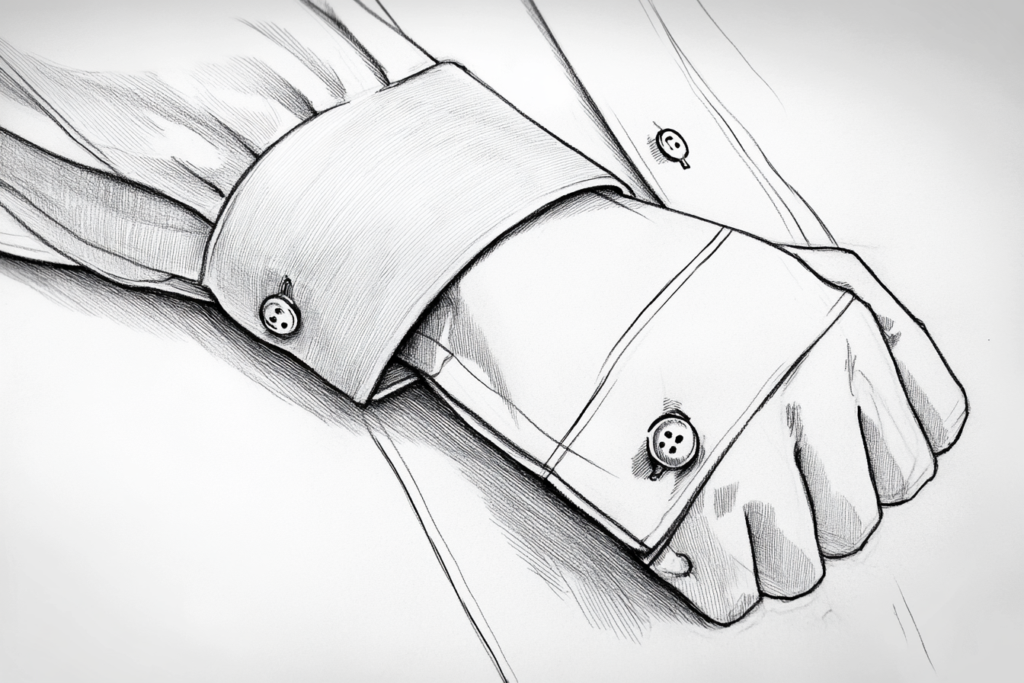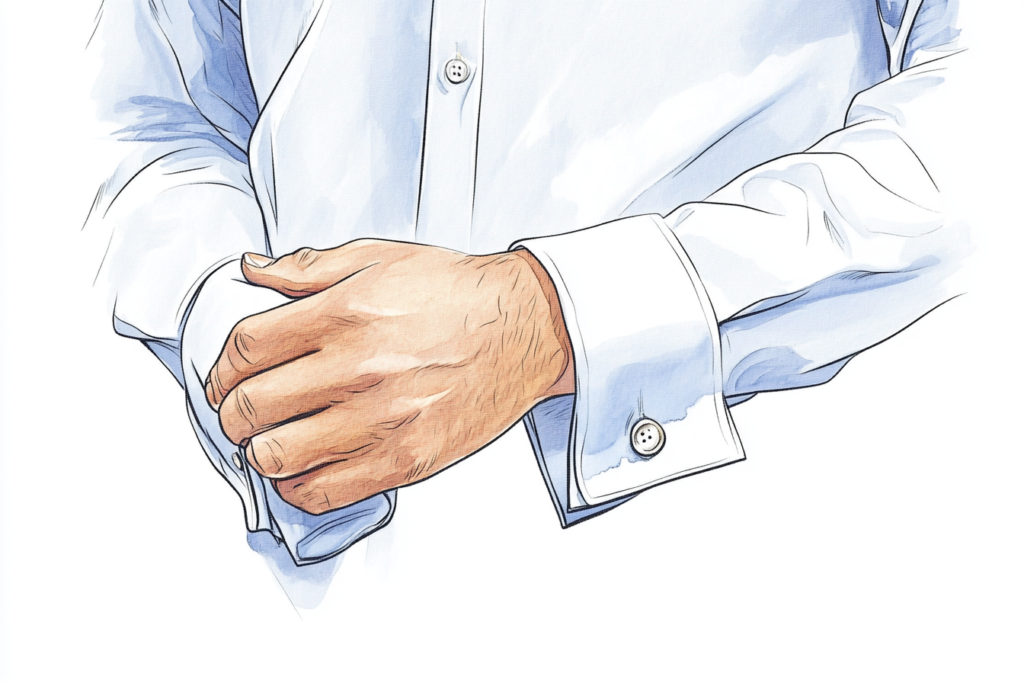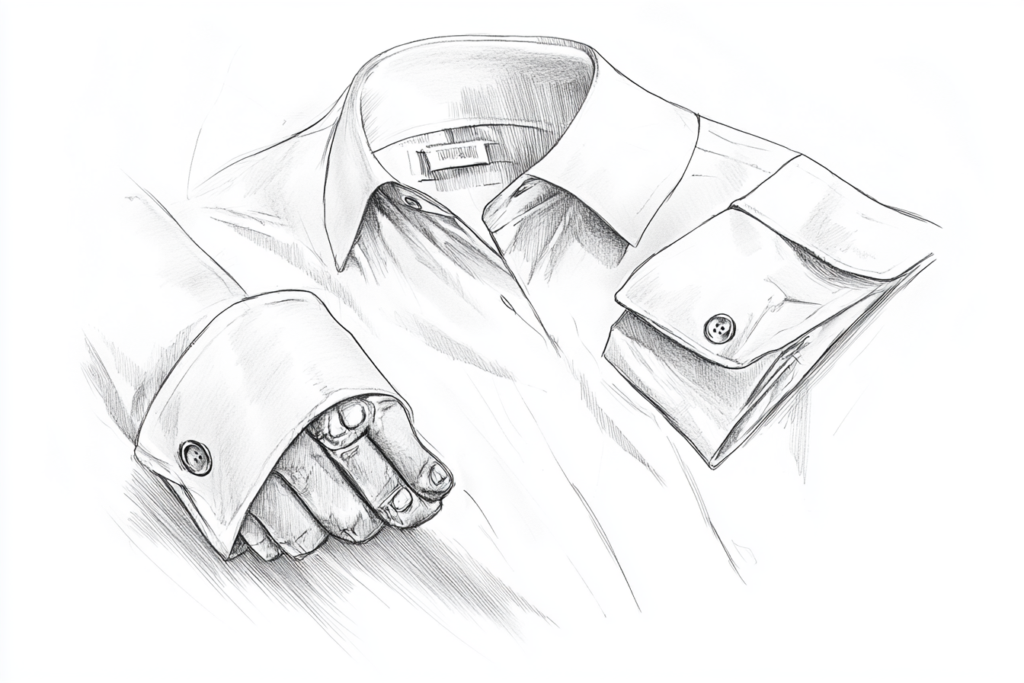Introduction: What Is a Cuff?
A cuff is a small but important detail often found at the opening of a sleeve or at the bottom of a trouser leg. It can serve both a functional and decorative purpose, adding style, structure, and finish to a garment. Whether it’s the crisp finish on a dress shirt or the tailored look on a pair of trousers, the cuff is an essential element in fashion design.
Cuffs are most commonly used in shirts, jackets, trousers, and skirts, where they finish off the garment’s edges. The design and type of cuff can vary depending on the garment, fabric, and overall aesthetic, but the core function of a cuff remains to add refinement and shape to the piece.


Types of Cuffs in Garment Design
- Shirt Cuffs:
- The most common cuffs are found on shirts, where they are located at the wrist opening. Shirt cuffs can be either single or double (French cuffs). Double cuffs are typically secured with cufflinks, adding a touch of sophistication to formal shirts.
- Trouser Cuffs:
- Cuffs at the bottom of trousers (also called a “pant cuff”) are often used in formal wear to add weight and structure to the fabric. Cuffed trousers are particularly popular in men’s fashion, especially in suits and dress trousers. The cuff can be turned up at the hem and sewn in place, giving the trousers a neat finish.
- Jacket Cuffs:
- Many jacket sleeves feature a small cuff at the wrist. This cuff may be either functional, with button closures, or purely decorative. A well-tailored jacket cuff creates a polished and professional appearance.
- Skirt or Dress Cuffs:
- Cuffs can also appear at the hemline of skirts or dresses. These cuffs can be wide or narrow, depending on the style, and are often made from the same material as the garment to maintain a consistent look.
How Cuffs Enhance Garment Fit and Aesthetics
- Providing Structure:
- Cuffs help to add structure to the edges of sleeves and pants, which can prevent fraying or stretching over time. For example, cuffed trousers add weight to the bottom of the pants, ensuring they hang well and do not shift out of place.
- Tailoring and Fit:
- A well-constructed cuff can improve the overall fit of a garment. For shirts, the cuff allows for flexibility in sleeve length and can be adjusted to create a clean, tailored look. Similarly, cuffed pants can help achieve the desired trouser length, ensuring a precise and professional fit.
- Decoration and Detailing:
- Aside from functionality, cuffs serve as a decorative element. The cuff design can feature different textures, fabrics, and finishes. For instance, a wide cuff on a shirt might be made from a contrasting fabric, such as a striped or patterned material, providing visual interest.
- Adding Formality:
- Cuffs on trousers and shirts are often associated with more formal styles. A cuffed trouser leg or French cuff shirt adds a polished, refined touch to the outfit, making it ideal for professional or evening wear.
How to Style Cuffs in Different Garments
- Shirts and Blouses:
- For a formal look, cuffs should be neatly fastened with cufflinks or buttons. For casual wear, cuffed sleeves can be rolled up to create a more relaxed, laid-back style. Double cuffs are often reserved for dress shirts and more formal occasions, while single cuffs are versatile and can be worn both casually and formally.
- Pants and Trousers:
- Cuffed trousers are a staple in classic menswear. They can be worn with both suits and casual attire, but they are especially suited to formal or semi-formal looks. To achieve a polished finish, ensure the cuff is even and aligned with the hemline of the trouser leg.
- Jackets and Blazers:
- When it comes to jackets, cuffs at the wrist are often added to create a finished appearance. A jacket with a cuffed sleeve looks more tailored and structured, making it ideal for formal business wear or evening attire. The cuff can be buttoned or left unbuttoned, depending on the desired style.
- Skirts and Dresses:
- A cuffed hem on a skirt or dress adds a touch of refinement and sophistication. This style is often seen in more structured pieces, like pencil skirts or tailored dresses, where the cuff creates a sharp, clean finish at the bottom.
Benefits of Cuffs in Fashion
- Versatility:
- Cuffs are incredibly versatile. They can be worn in both formal and casual settings, allowing designers to incorporate them into a wide range of garments and outfits.
- Durability:
- Cuffs help to reinforce the edges of sleeves and pants, making them more durable. This is especially important in garments that are frequently worn or exposed to movement, such as trousers and shirts.
- Timeless Elegance:
- The presence of cuffs in a garment often conveys timeless style and sophistication. Whether it’s a cuffed sleeve on a shirt or a cuffed pant leg, this detail adds a level of elegance that is never out of fashion.
- Customizable:
- Designers can customize cuffs to match the overall design of the garment. From the fabric choice to the size and shape of the cuff, this detail allows for personal expression and styling.
Conclusion: The Timeless Appeal of Cuffs in Fashion
Cuffs are a fundamental element of garment design, playing both a functional and aesthetic role. Whether at the end of a sleeve, the bottom of a trouser leg, or as a decorative feature on a jacket or dress, cuffs contribute to the overall structure, fit, and visual appeal of a garment. Understanding how to use cuffs effectively allows designers to create garments that are both stylish and functional, with a sophisticated finish that appeals to a variety of occasions.
Whether you’re dressing for a business meeting, a formal event, or casual wear, the right cuff detail can make a significant difference in the overall look and feel of the outfit.



